service indicator MINI 3 door 2015 Owner's Manual
[x] Cancel search | Manufacturer: MINI, Model Year: 2015, Model line: 3 door, Model: MINI 3 door 2015Pages: 248, PDF Size: 5.43 MB
Page 79 of 248

DSC Dynamic Stability Control is deactivated
or DTC Dynamic Traction Control is activated
Dynamic Stability Control DSC is
switched off or Dynamic Traction Conā
trol DTC is switched on.
For additional information, refer to Dynamic
Stability Control DSC, refer to page 116, and
Dynamic Traction Control DTC, refer to
page 117.
Flat Tire Monitor FTM The Flat Tire Monitor signals a loss of
tire inflation pressure in a tire.
Reduce your speed and stop cautiously.
Avoid sudden braking and steering maneuvers.
For additional information, refer to Flat Tire
Monitor, refer to page 107.
Tire Pressure Monitor TPM Illuminated: the Tire Pressure Monitor
signals a loss of tire inflation pressure in
a tire.
Reduce your speed and stop cautiously. Avoid
sudden braking and steering maneuvers.
Flashing and then continuously illuminated: no
flat tire or loss of tire inflation pressure can be
detected.ā·Interference through systems or devices
with the same radio frequency: After leavā
ing the area of the interference, the system
automatically becomes active again.ā·TPM was unable to complete the reset. Reā
set the system again.ā·A wheel without TPM electronics is
mounted: Have it checked by a dealerās
service center or another qualified service
center or repair shop as needed.ā·Malfunction: have the system checked by a
dealerās service center or another qualified
service center or repair shop.For additional information, refer to Tire Presā
sure Monitor, refer to page 103.
Steering system Steering system in some cases not
working.
Have the steering system checked by a
dealerās service center or another qualified
service center or repair shop.
Engine functions Have the vehicle checked by a dealerās
service center or another qualified servā
ice center or repair shop.
For additional information, refer to On-board
Diagnostics socket, refer to page 203.
Rear fog lamp Rear fog lights are activated.
For additional information, refer to Rear
fog lights, refer to page 98.
Green lights Turn signal Turn signal switched on.
Unusually rapid flashing of the indicator
lamp indicates that a turn signal bulb
has failed.
For additional information, refer to Turn signal,
refer to page 67.
Parking lights, headlight control Parking lights or headlights are actiā
vated.
For additional information, refer to
Parking lights/low beams, headlight control, reā
fer to page 95.Seite 79DisplaysCONTROLS79
Online Edition for Part no. 01 40 2 964 625 - X/15
Page 80 of 248
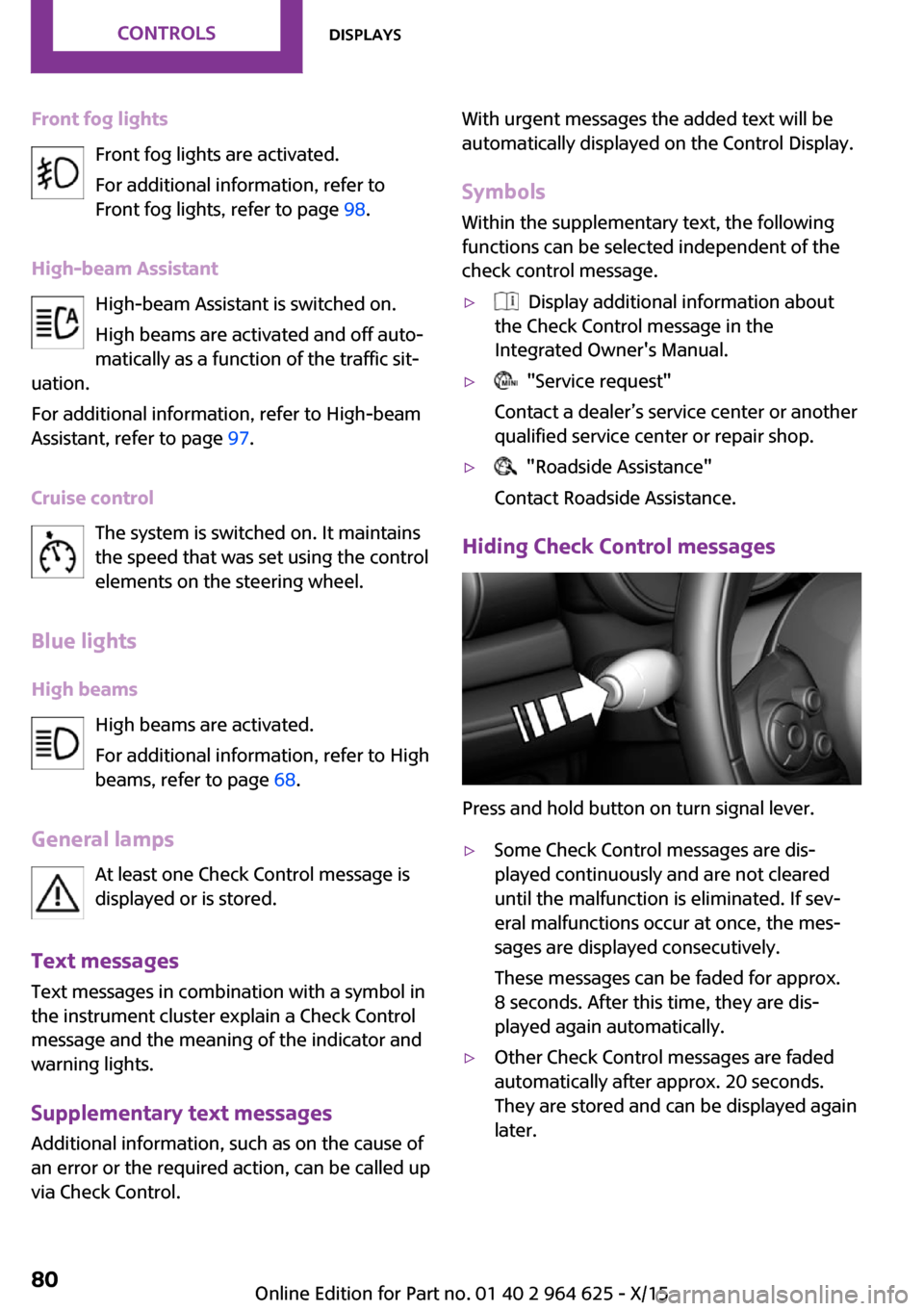
Front fog lightsFront fog lights are activated.
For additional information, refer to
Front fog lights, refer to page 98.
High-beam Assistant High-beam Assistant is switched on.
High beams are activated and off autoā
matically as a function of the traffic sitā
uation.
For additional information, refer to High-beam
Assistant, refer to page 97.
Cruise control The system is switched on. It maintains
the speed that was set using the control
elements on the steering wheel.
Blue lights
High beams High beams are activated.
For additional information, refer to High
beams, refer to page 68.
General lamps At least one Check Control message is
displayed or is stored.
Text messages
Text messages in combination with a symbol in
the instrument cluster explain a Check Control
message and the meaning of the indicator and
warning lights.
Supplementary text messages
Additional information, such as on the cause of
an error or the required action, can be called up
via Check Control.With urgent messages the added text will be
automatically displayed on the Control Display.
Symbols
Within the supplementary text, the following
functions can be selected independent of the
check control message.ā· Display additional information about
the Check Control message in the
Integrated Owner's Manual.ā· "Service request"
Contact a dealerās service center or another
qualified service center or repair shop.ā· "Roadside Assistance"
Contact Roadside Assistance.
Hiding Check Control messages
Press and hold button on turn signal lever.
ā·Some Check Control messages are disā
played continuously and are not cleared
until the malfunction is eliminated. If sevā
eral malfunctions occur at once, the mesā
sages are displayed consecutively.
These messages can be faded for approx.
8 seconds. After this time, they are disā
played again automatically.ā·Other Check Control messages are faded
automatically after approx. 20 seconds.
They are stored and can be displayed again
later.Seite 80CONTROLSDisplays80
Online Edition for Part no. 01 40 2 964 625 - X/15
Page 83 of 248
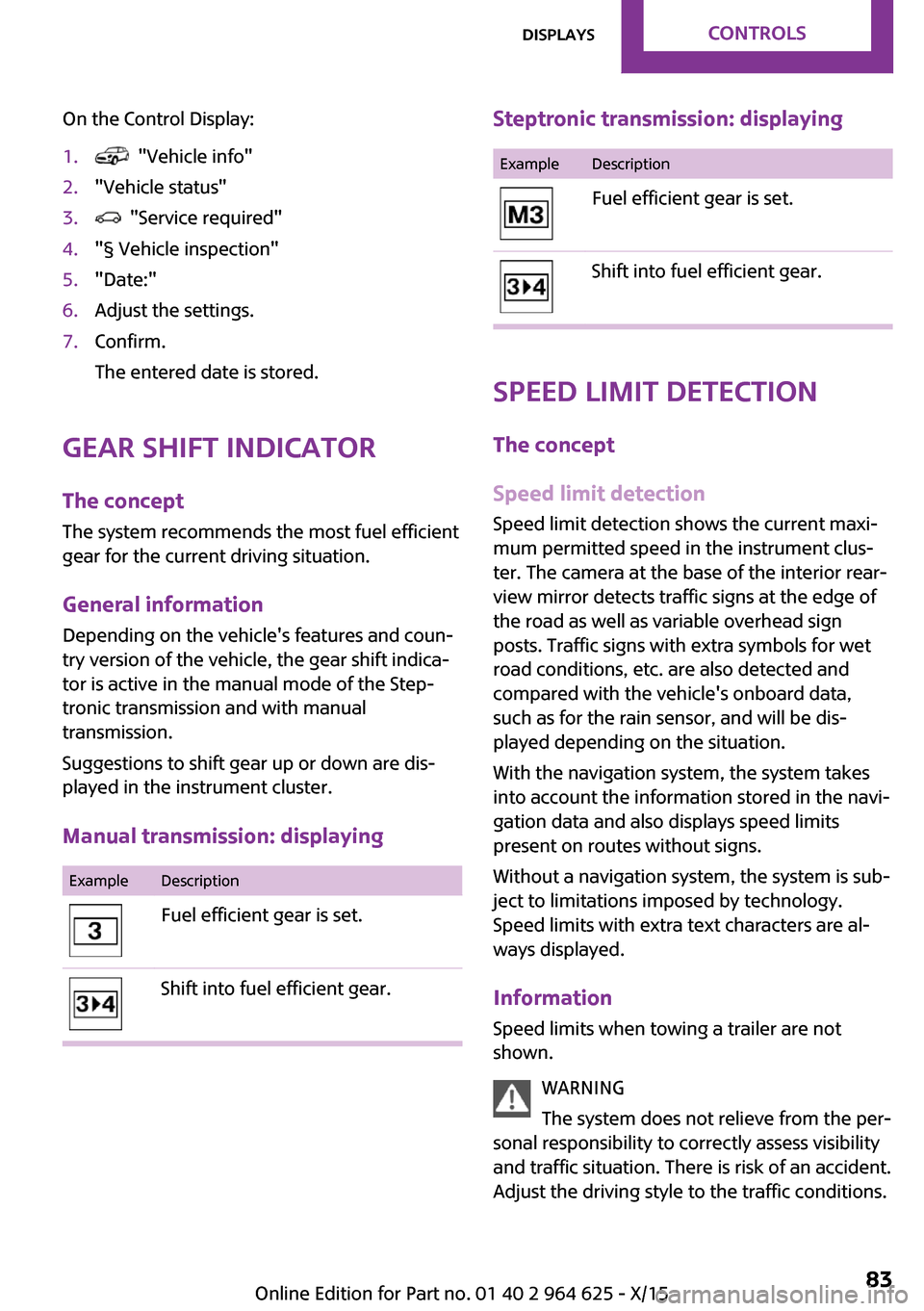
On the Control Display:1. "Vehicle info"2."Vehicle status"3. "Service required"4."Ā§ Vehicle inspection"5."Date:"6.Adjust the settings.7.Confirm.
The entered date is stored.
Gear shift indicator
The concept
The system recommends the most fuel efficient
gear for the current driving situation.
General information Depending on the vehicle's features and counā
try version of the vehicle, the gear shift indicaā
tor is active in the manual mode of the Stepā
tronic transmission and with manual
transmission.
Suggestions to shift gear up or down are disā
played in the instrument cluster.
Manual transmission: displaying
ExampleDescriptionFuel efficient gear is set.Shift into fuel efficient gear.Steptronic transmission: displayingExampleDescriptionFuel efficient gear is set.Shift into fuel efficient gear.
Speed limit detection
The concept
Speed limit detection
Speed limit detection shows the current maxiā
mum permitted speed in the instrument clusā
ter. The camera at the base of the interior rearā
view mirror detects traffic signs at the edge of
the road as well as variable overhead sign
posts. Traffic signs with extra symbols for wet
road conditions, etc. are also detected and
compared with the vehicle's onboard data,
such as for the rain sensor, and will be disā
played depending on the situation.
With the navigation system, the system takes
into account the information stored in the naviā
gation data and also displays speed limits
present on routes without signs.
Without a navigation system, the system is subā
ject to limitations imposed by technology.
Speed limits with extra text characters are alā
ways displayed.
Information
Speed limits when towing a trailer are not
shown.
WARNING
The system does not relieve from the perā
sonal responsibility to correctly assess visibility
and traffic situation. There is risk of an accident.
Adjust the driving style to the traffic conditions.
Seite 83DisplaysCONTROLS83
Online Edition for Part no. 01 40 2 964 625 - X/15
Page 97 of 248
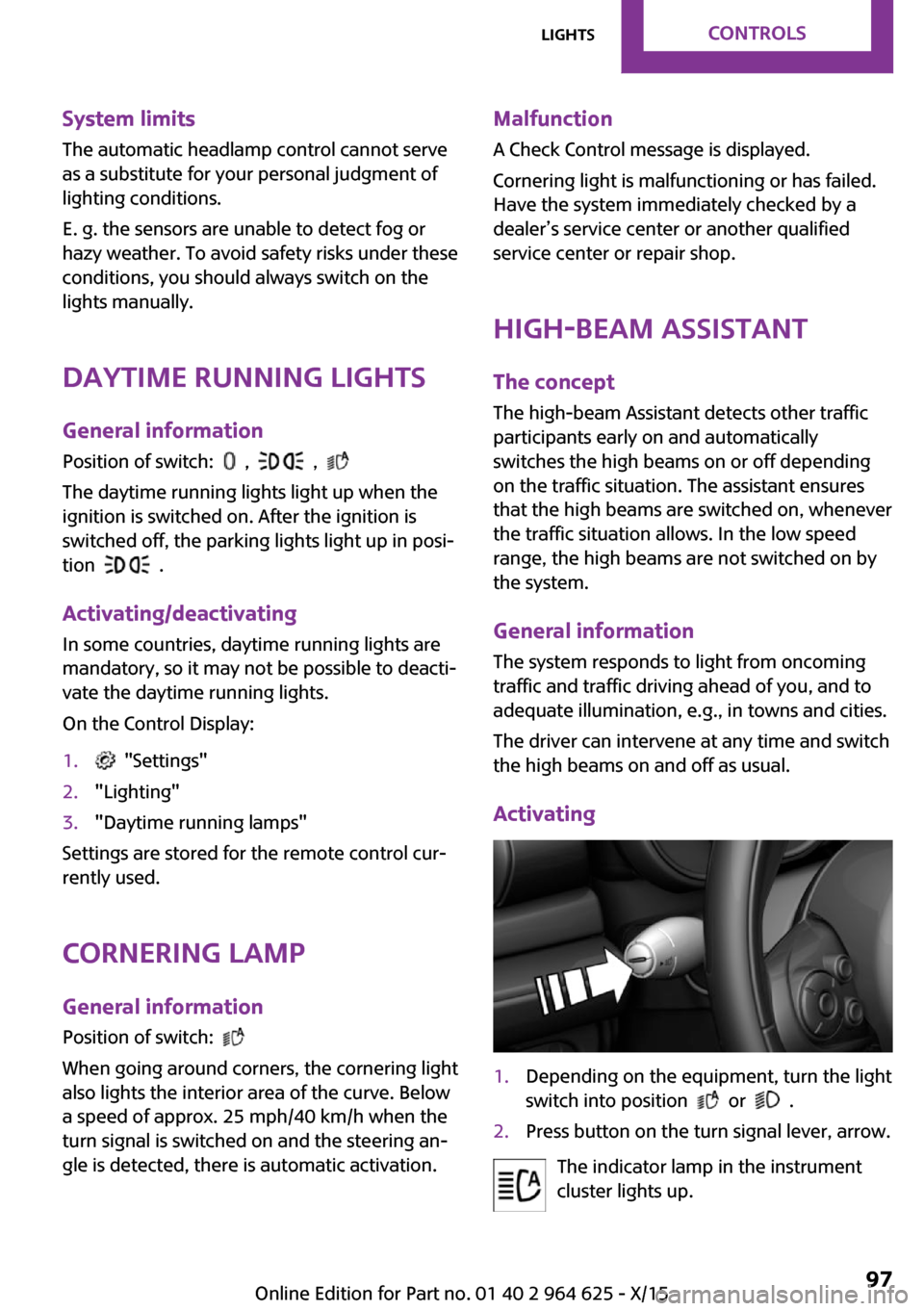
System limits
The automatic headlamp control cannot serve
as a substitute for your personal judgment of
lighting conditions.
E. g. the sensors are unable to detect fog or
hazy weather. To avoid safety risks under these
conditions, you should always switch on the
lights manually.
Daytime running lights General information
Position of switch:
, ,
The daytime running lights light up when the
ignition is switched on. After the ignition is
switched off, the parking lights light up in posiā
tion
.
Activating/deactivating
In some countries, daytime running lights are
mandatory, so it may not be possible to deactiā vate the daytime running lights.
On the Control Display:
1. "Settings"2."Lighting"3."Daytime running lamps"
Settings are stored for the remote control curā
rently used.
Cornering lamp General information Position of switch:
When going around corners, the cornering light
also lights the interior area of the curve. Below
a speed of approx. 25 mph/40 km/h when the
turn signal is switched on and the steering anā
gle is detected, there is automatic activation.
Malfunction
A Check Control message is displayed.
Cornering light is malfunctioning or has failed.
Have the system immediately checked by a
dealerās service center or another qualified
service center or repair shop.
High-beam Assistant The concept The high-beam Assistant detects other traffic
participants early on and automatically
switches the high beams on or off depending
on the traffic situation. The assistant ensures
that the high beams are switched on, whenever
the traffic situation allows. In the low speed
range, the high beams are not switched on by
the system.
General information The system responds to light from oncoming
traffic and traffic driving ahead of you, and to
adequate illumination, e.g., in towns and cities.
The driver can intervene at any time and switch
the high beams on and off as usual.
Activating1.Depending on the equipment, turn the light
switch into position
or .
2.Press button on the turn signal lever, arrow.
The indicator lamp in the instrument
cluster lights up.
Seite 97LightsCONTROLS97
Online Edition for Part no. 01 40 2 964 625 - X/15
Page 102 of 248
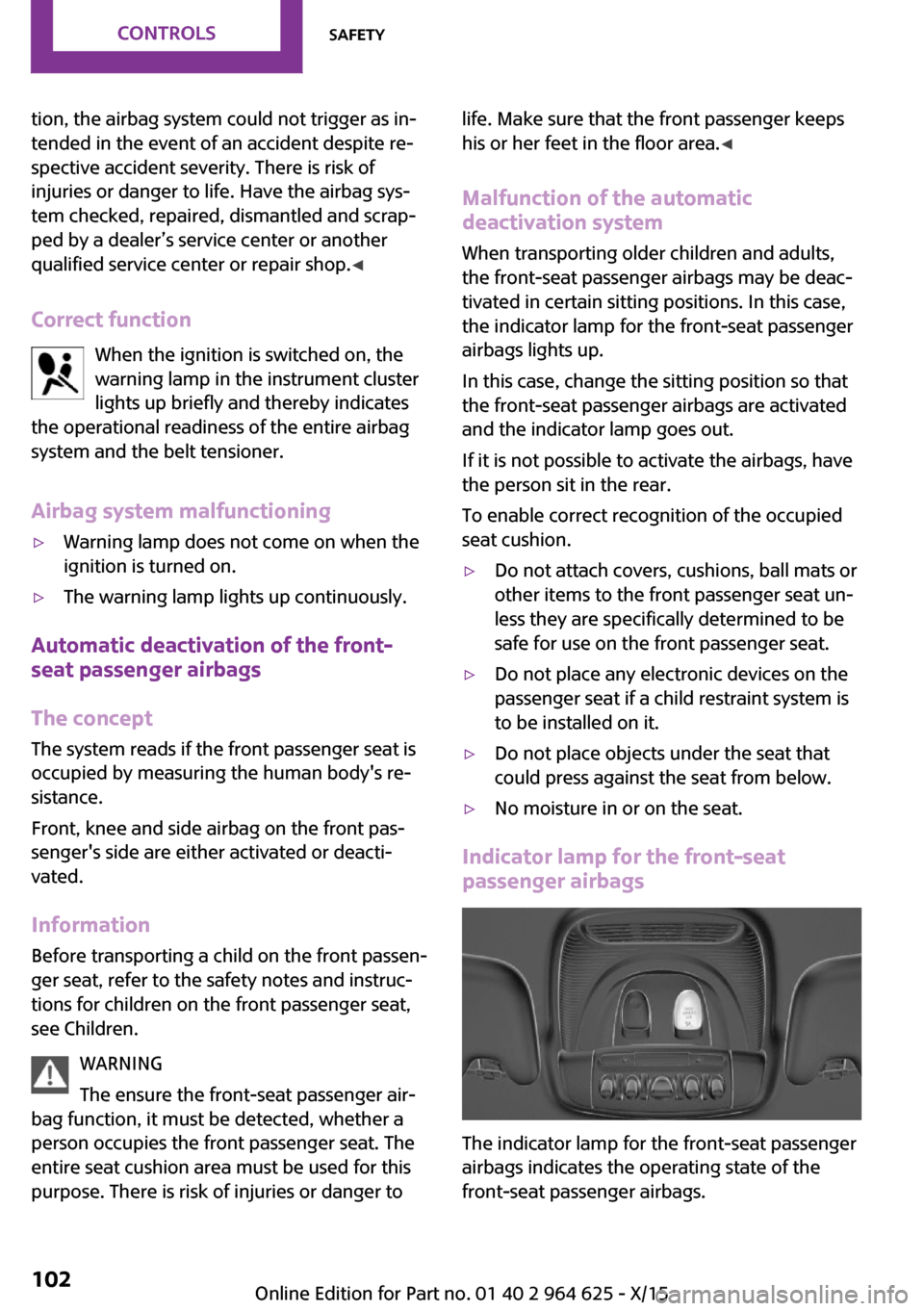
tion, the airbag system could not trigger as inā
tended in the event of an accident despite reā
spective accident severity. There is risk of
injuries or danger to life. Have the airbag sysā
tem checked, repaired, dismantled and scrapā
ped by a dealerās service center or another
qualified service center or repair shop. ā
Correct function When the ignition is switched on, the
warning lamp in the instrument cluster
lights up briefly and thereby indicates
the operational readiness of the entire airbag
system and the belt tensioner.
Airbag system malfunctioningā·Warning lamp does not come on when the
ignition is turned on.ā·The warning lamp lights up continuously.
Automatic deactivation of the front-
seat passenger airbags
The concept
The system reads if the front passenger seat is
occupied by measuring the human body's reā
sistance.
Front, knee and side airbag on the front pasā
senger's side are either activated or deactiā
vated.
Information Before transporting a child on the front passenā
ger seat, refer to the safety notes and instrucā
tions for children on the front passenger seat,
see Children.
WARNING
The ensure the front-seat passenger airā
bag function, it must be detected, whether a
person occupies the front passenger seat. The
entire seat cushion area must be used for this
purpose. There is risk of injuries or danger to
life. Make sure that the front passenger keeps
his or her feet in the floor area. ā
Malfunction of the automatic deactivation system
When transporting older children and adults,
the front-seat passenger airbags may be deacā
tivated in certain sitting positions. In this case,
the indicator lamp for the front-seat passenger
airbags lights up.
In this case, change the sitting position so that
the front-seat passenger airbags are activated
and the indicator lamp goes out.
If it is not possible to activate the airbags, have
the person sit in the rear.
To enable correct recognition of the occupied
seat cushion.ā·Do not attach covers, cushions, ball mats or
other items to the front passenger seat unā
less they are specifically determined to be
safe for use on the front passenger seat.ā·Do not place any electronic devices on the
passenger seat if a child restraint system is
to be installed on it.ā·Do not place objects under the seat that
could press against the seat from below.ā·No moisture in or on the seat.
Indicator lamp for the front-seat
passenger airbags
The indicator lamp for the front-seat passenger
airbags indicates the operating state of the
front-seat passenger airbags.
Seite 102CONTROLSSafety102
Online Edition for Part no. 01 40 2 964 625 - X/15
Page 109 of 248
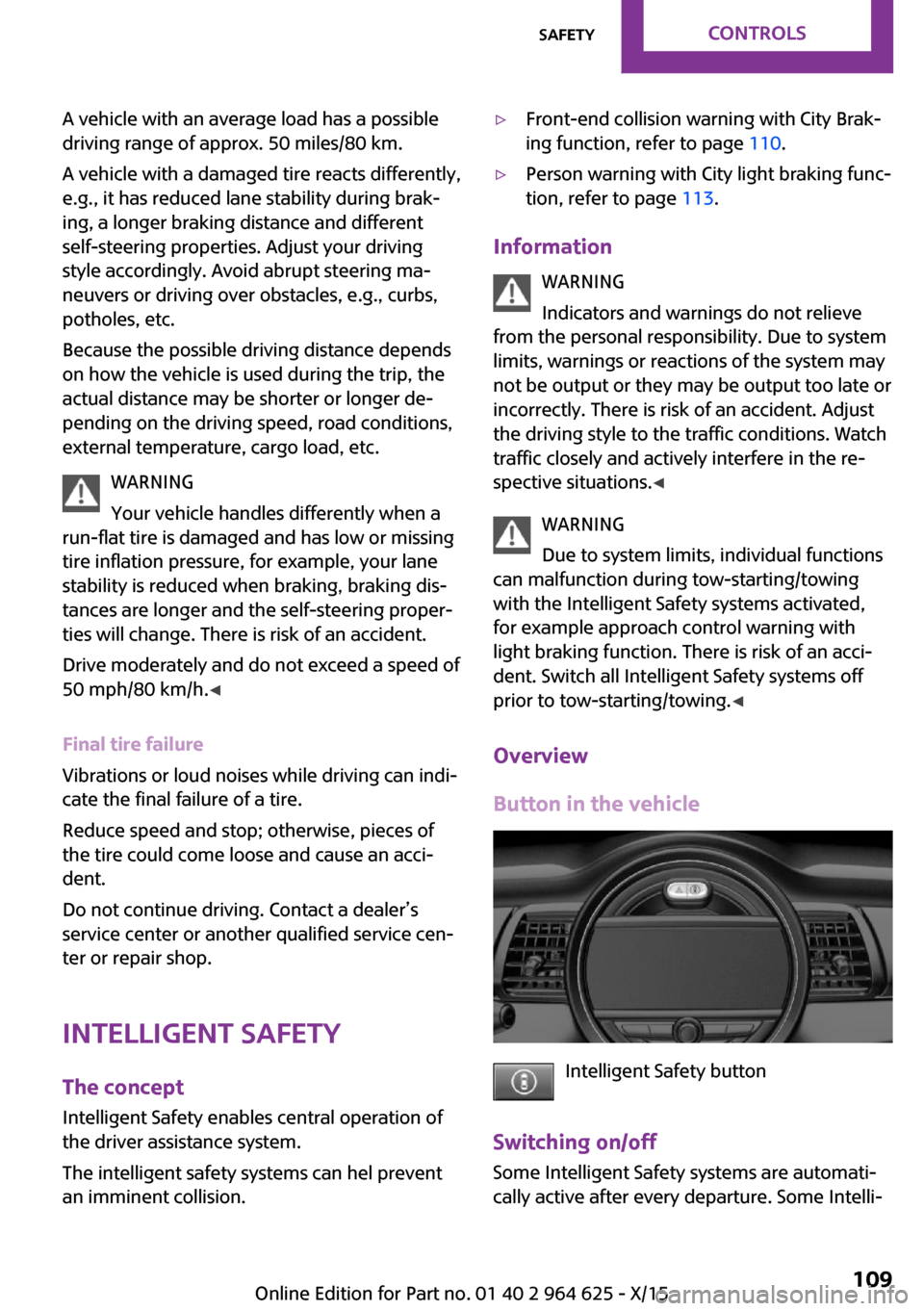
A vehicle with an average load has a possible
driving range of approx. 50 miles/80 km.
A vehicle with a damaged tire reacts differently,
e.g., it has reduced lane stability during brakā
ing, a longer braking distance and different
self-steering properties. Adjust your driving
style accordingly. Avoid abrupt steering maā
neuvers or driving over obstacles, e.g., curbs,
potholes, etc.
Because the possible driving distance depends
on how the vehicle is used during the trip, the
actual distance may be shorter or longer deā
pending on the driving speed, road conditions,
external temperature, cargo load, etc.
WARNING
Your vehicle handles differently when a
run-flat tire is damaged and has low or missing
tire inflation pressure, for example, your lane
stability is reduced when braking, braking disā
tances are longer and the self-steering properā
ties will change. There is risk of an accident.
Drive moderately and do not exceed a speed of
50 mph/80 km/h. ā
Final tire failure
Vibrations or loud noises while driving can indiā
cate the final failure of a tire.
Reduce speed and stop; otherwise, pieces of
the tire could come loose and cause an acciā
dent.
Do not continue driving. Contact a dealerās
service center or another qualified service cenā
ter or repair shop.
Intelligent Safety
The concept
Intelligent Safety enables central operation of
the driver assistance system.
The intelligent safety systems can hel prevent
an imminent collision.ā·Front-end collision warning with City Brakā
ing function, refer to page 110.ā·Person warning with City light braking funcā
tion, refer to page 113.
Information
WARNING
Indicators and warnings do not relieve
from the personal responsibility. Due to system
limits, warnings or reactions of the system may
not be output or they may be output too late or
incorrectly. There is risk of an accident. Adjust
the driving style to the traffic conditions. Watch
traffic closely and actively interfere in the reā
spective situations. ā
WARNING
Due to system limits, individual functions
can malfunction during tow-starting/towing
with the Intelligent Safety systems activated, for example approach control warning with
light braking function. There is risk of an acciā
dent. Switch all Intelligent Safety systems off
prior to tow-starting/towing. ā
Overview
Button in the vehicle
Intelligent Safety button
Switching on/off Some Intelligent Safety systems are automatiā
cally active after every departure. Some Intelliā
Seite 109SafetyCONTROLS109
Online Edition for Part no. 01 40 2 964 625 - X/15
Page 167 of 248
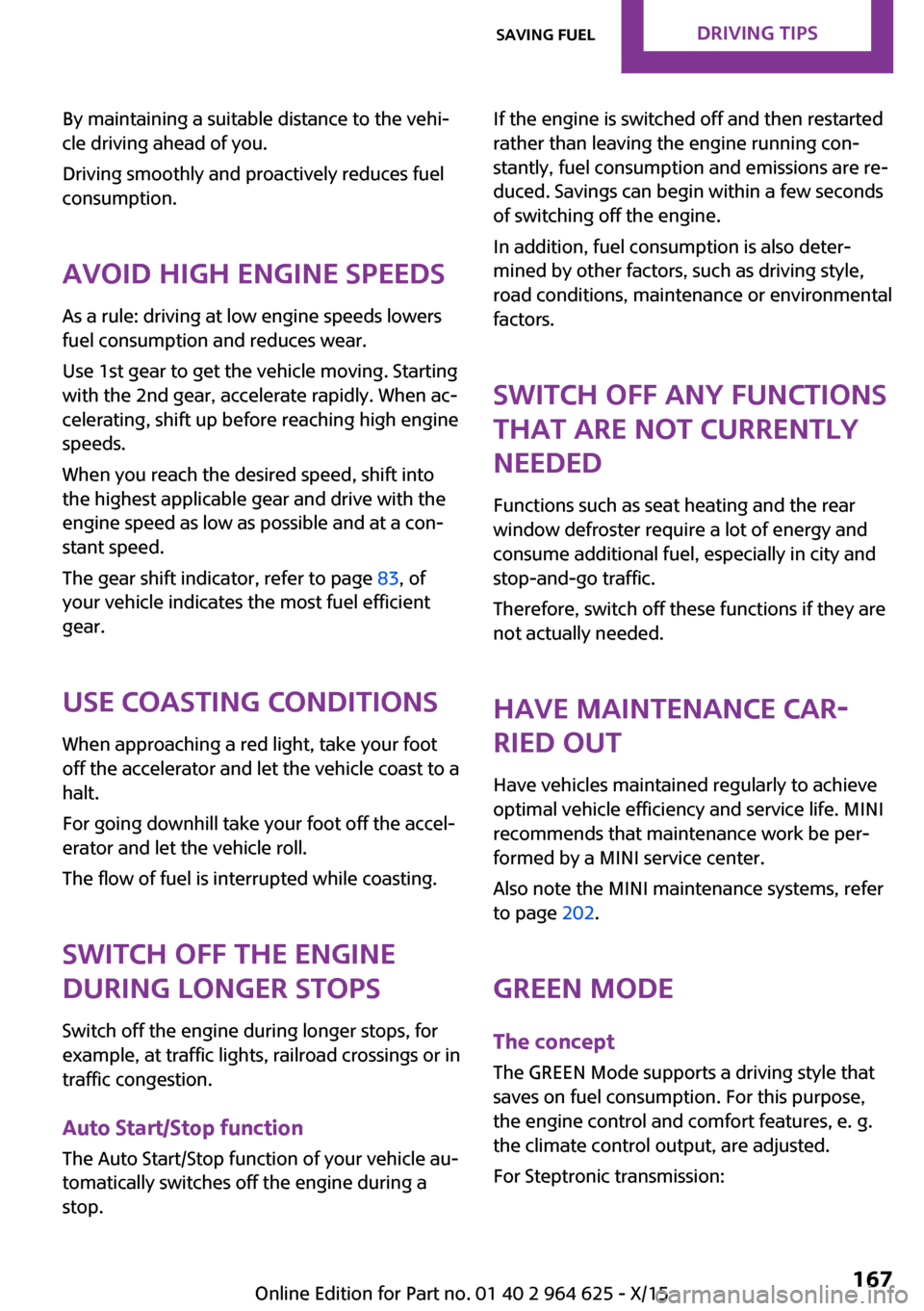
By maintaining a suitable distance to the vehiā
cle driving ahead of you.
Driving smoothly and proactively reduces fuel
consumption.
Avoid high engine speeds
As a rule: driving at low engine speeds lowers
fuel consumption and reduces wear.
Use 1st gear to get the vehicle moving. Starting
with the 2nd gear, accelerate rapidly. When acā
celerating, shift up before reaching high engine
speeds.
When you reach the desired speed, shift into
the highest applicable gear and drive with the
engine speed as low as possible and at a conā
stant speed.
The gear shift indicator, refer to page 83, of
your vehicle indicates the most fuel efficient gear.
Use coasting conditions When approaching a red light, take your foot
off the accelerator and let the vehicle coast to a
halt.
For going downhill take your foot off the accelā
erator and let the vehicle roll.
The flow of fuel is interrupted while coasting.
Switch off the engine
during longer stops
Switch off the engine during longer stops, for
example, at traffic lights, railroad crossings or in
traffic congestion.
Auto Start/Stop function
The Auto Start/Stop function of your vehicle auā
tomatically switches off the engine during a
stop.If the engine is switched off and then restarted
rather than leaving the engine running conā
stantly, fuel consumption and emissions are reā
duced. Savings can begin within a few seconds
of switching off the engine.
In addition, fuel consumption is also deterā
mined by other factors, such as driving style,
road conditions, maintenance or environmental
factors.
Switch off any functions
that are not currently
needed
Functions such as seat heating and the rear
window defroster require a lot of energy and
consume additional fuel, especially in city and
stop-and-go traffic.
Therefore, switch off these functions if they are
not actually needed.
Have maintenance carā
ried out
Have vehicles maintained regularly to achieve
optimal vehicle efficiency and service life. MINI
recommends that maintenance work be perā
formed by a MINI service center.
Also note the MINI maintenance systems, refer
to page 202.
GREEN Mode
The concept The GREEN Mode supports a driving style that
saves on fuel consumption. For this purpose,
the engine control and comfort features, e. g.
the climate control output, are adjusted.
For Steptronic transmission:Seite 167Saving fuelDRIVING TIPS167
Online Edition for Part no. 01 40 2 964 625 - X/15
Page 187 of 248
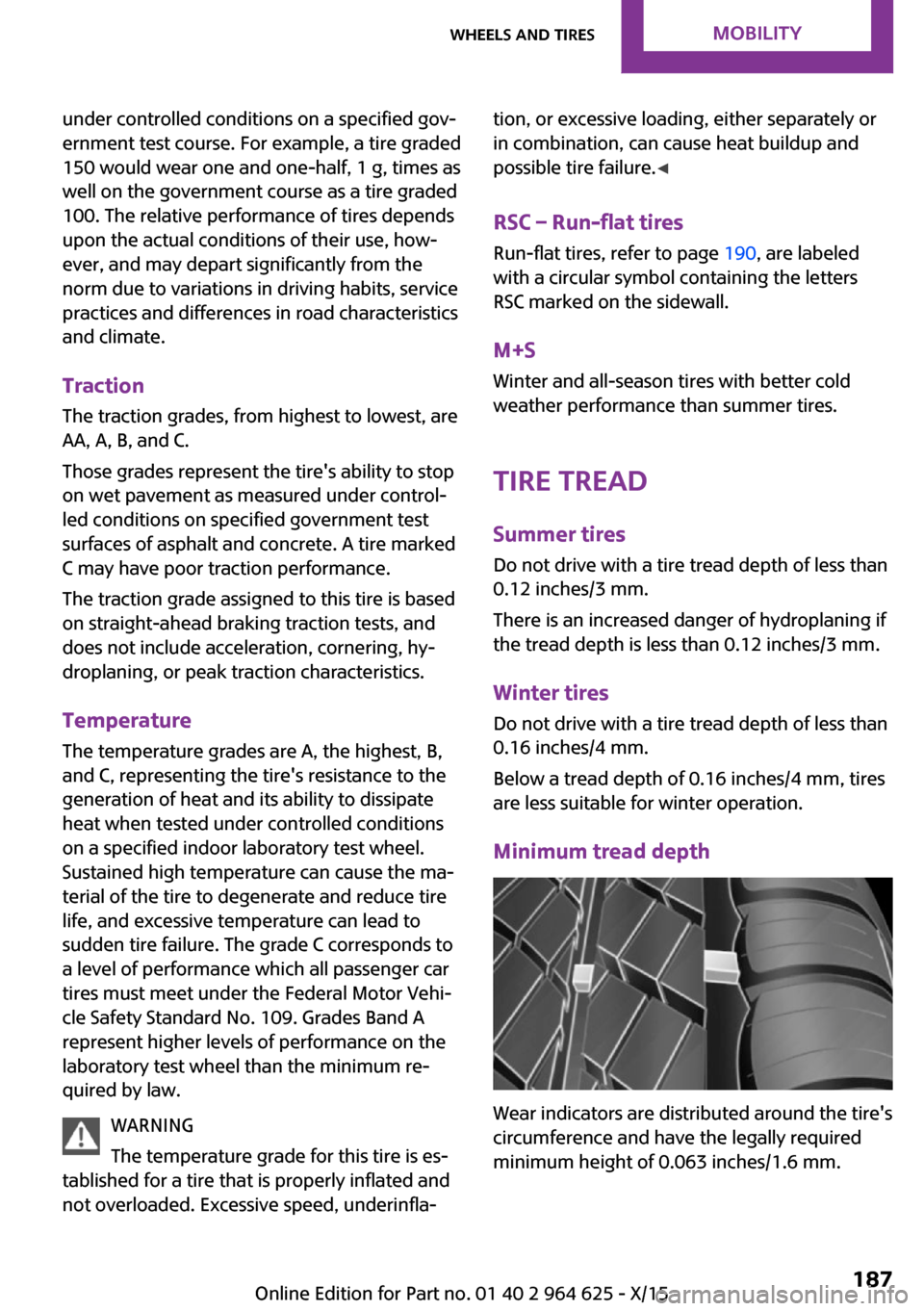
under controlled conditions on a specified govā
ernment test course. For example, a tire graded
150 would wear one and one-half, 1 g, times as
well on the government course as a tire graded
100. The relative performance of tires depends
upon the actual conditions of their use, howā
ever, and may depart significantly from the
norm due to variations in driving habits, service
practices and differences in road characteristics
and climate.
Traction The traction grades, from highest to lowest, are
AA, A, B, and C.
Those grades represent the tire's ability to stop
on wet pavement as measured under controlā
led conditions on specified government test
surfaces of asphalt and concrete. A tire marked
C may have poor traction performance.
The traction grade assigned to this tire is based
on straight-ahead braking traction tests, and
does not include acceleration, cornering, hyā
droplaning, or peak traction characteristics.
Temperature The temperature grades are A, the highest, B,
and C, representing the tire's resistance to the
generation of heat and its ability to dissipate
heat when tested under controlled conditions
on a specified indoor laboratory test wheel.
Sustained high temperature can cause the maā
terial of the tire to degenerate and reduce tire
life, and excessive temperature can lead to
sudden tire failure. The grade C corresponds to
a level of performance which all passenger car
tires must meet under the Federal Motor Vehiā
cle Safety Standard No. 109. Grades Band A
represent higher levels of performance on the
laboratory test wheel than the minimum reā
quired by law.
WARNING
The temperature grade for this tire is esā
tablished for a tire that is properly inflated and
not overloaded. Excessive speed, underinflaātion, or excessive loading, either separately or
in combination, can cause heat buildup and
possible tire failure. ā
RSC ā Run-flat tires
Run-flat tires, refer to page 190, are labeled
with a circular symbol containing the letters
RSC marked on the sidewall.
M+S
Winter and all-season tires with better cold
weather performance than summer tires.
Tire tread Summer tiresDo not drive with a tire tread depth of less than
0.12 inches/3 mm.
There is an increased danger of hydroplaning if
the tread depth is less than 0.12 inches/3 mm.
Winter tires Do not drive with a tire tread depth of less than
0.16 inches/4 mm.
Below a tread depth of 0.16 inches/4 mm, tires
are less suitable for winter operation.
Minimum tread depth
Wear indicators are distributed around the tire's
circumference and have the legally required
minimum height of 0.063 inches/1.6 mm.
Seite 187Wheels and tiresMOBILITY187
Online Edition for Part no. 01 40 2 964 625 - X/15
Page 188 of 248

They are marked on the side of the tire with
TWI, Tread Wear Indicator.
Tire damage General information
Inspect your tires regularly for damage, foreign
objects lodged in the tread, and tread wear.
Information Driving over rough or damaged road surfaces,
as well as debris, curbs and other obstacles can
cause serious damage to wheels, tires and susā
pension parts. This is more likely to occur with
low-profile tires, which provide less cushioning
between the wheel and the road. Be careful to
avoid road hazards and reduce your speed, esā
pecially if your vehicle is equipped with low-
profile tires.
Indications of tire damage or other vehicle malā
functions:ā·Unusual vibrations while driving.ā·Unusual handling such as a strong tenā
dency to pull to the left or right.
Damage can, e. g., be caused by driving over
curbs, road damage, or similar things.
WARNING
Damaged tires can lose tire inflation presā
sure, which can lead to loss of vehicle control.
There is risk of an accident. If tire damage is
suspected while driving, immediately reduce
speed and stop. Have wheels and tires
checked. For this purpose, drive carefully to the
nearest dealerās service center or another
qualified service center or repair shop. Have
vehicle towed or transported as needed. ā
WARNING
Damaged tires can lose tire inflation presā
sure, which can lead to loss of vehicle control.
There is risk of an accident. Do not repair damā
aged tires, but have them replaced. ā
Changing wheels and
tires
Mounting Have mounting and wheel balancing carried
out by a dealerās service center or another
qualified service center or repair shop.
Wheel and tire combination
You can ask the dealerās service center or anā
other qualified service center or repair shop
about the right wheel/tire combination and
wheel rim versions for the vehicle.
Incorrect wheel and tire combinations impair
the function of a variety of systems such as ABS
or DSC.
To maintain good handling and vehicle reā
sponse, use only tires with a single tread conā
figuration from a single manufacturer.
Following tire damage, have the original wheel
and tire combination remounted on the vehicle
as soon as possible.
WARNING
Wheels and tires which are not suitable
for your vehicle can damage parts of the vehiā
cle, e.g. due to contact with the body due to
tolerances despite the same official size rating.
There is risk of an accident. The manufacturer
of your vehicle strongly suggests that you use
wheels and tires that have been recommended
by the vehicle manufacturer for your vehicle
type. āSeite 188MOBILITYWheels and tires188
Online Edition for Part no. 01 40 2 964 625 - X/15
Page 244 of 248
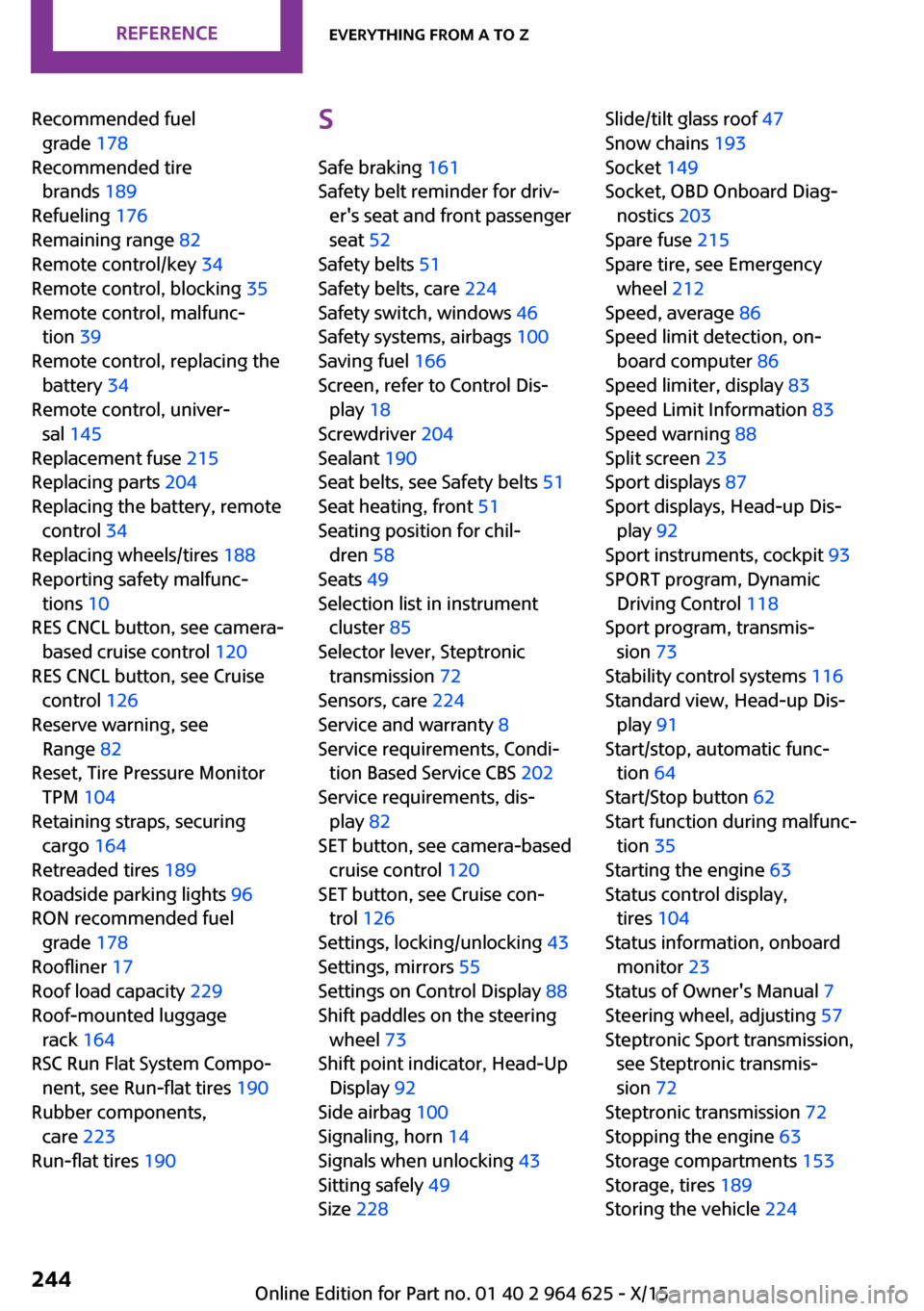
Recommended fuelgrade 178
Recommended tire brands 189
Refueling 176
Remaining range 82
Remote control/key 34
Remote control, blocking 35
Remote control, malfuncā tion 39
Remote control, replacing the battery 34
Remote control, univerā sal 145
Replacement fuse 215
Replacing parts 204
Replacing the battery, remote control 34
Replacing wheels/tires 188
Reporting safety malfuncā tions 10
RES CNCL button, see camera- based cruise control 120
RES CNCL button, see Cruise control 126
Reserve warning, see Range 82
Reset, Tire Pressure Monitor TPM 104
Retaining straps, securing cargo 164
Retreaded tires 189
Roadside parking lights 96
RON recommended fuel grade 178
Roofliner 17
Roof load capacity 229
Roof-mounted luggage rack 164
RSC Run Flat System Compoā nent, see Run-flat tires 190
Rubber components, care 223
Run-flat tires 190 S
Safe braking 161
Safety belt reminder for drivā er's seat and front passenger
seat 52
Safety belts 51
Safety belts, care 224
Safety switch, windows 46
Safety systems, airbags 100
Saving fuel 166
Screen, refer to Control Disā play 18
Screwdriver 204
Sealant 190
Seat belts, see Safety belts 51
Seat heating, front 51
Seating position for chilā dren 58
Seats 49
Selection list in instrument cluster 85
Selector lever, Steptronic transmission 72
Sensors, care 224
Service and warranty 8
Service requirements, Condiā tion Based Service CBS 202
Service requirements, disā play 82
SET button, see camera-based cruise control 120
SET button, see Cruise conā trol 126
Settings, locking/unlocking 43
Settings, mirrors 55
Settings on Control Display 88
Shift paddles on the steering wheel 73
Shift point indicator, Head-Up Display 92
Side airbag 100
Signaling, horn 14
Signals when unlocking 43
Sitting safely 49
Size 228 Slide/tilt glass roof 47
Snow chains 193
Socket 149
Socket, OBD Onboard Diagā nostics 203
Spare fuse 215
Spare tire, see Emergency wheel 212
Speed, average 86
Speed limit detection, onā board computer 86
Speed limiter, display 83
Speed Limit Information 83
Speed warning 88
Split screen 23
Sport displays 87
Sport displays, Head-up Disā play 92
Sport instruments, cockpit 93
SPORT program, Dynamic Driving Control 118
Sport program, transmisā sion 73
Stability control systems 116
Standard view, Head-up Disā play 91
Start/stop, automatic funcā tion 64
Start/Stop button 62
Start function during malfuncā tion 35
Starting the engine 63
Status control display, tires 104
Status information, onboard monitor 23
Status of Owner's Manual 7
Steering wheel, adjusting 57
Steptronic Sport transmission, see Steptronic transmisā
sion 72
Steptronic transmission 72
Stopping the engine 63
Storage compartments 153
Storage, tires 189
Storing the vehicle 224 Seite 244REFERENCEEverything from A to Z244
Online Edition for Part no. 01 40 2 964 625 - X/15